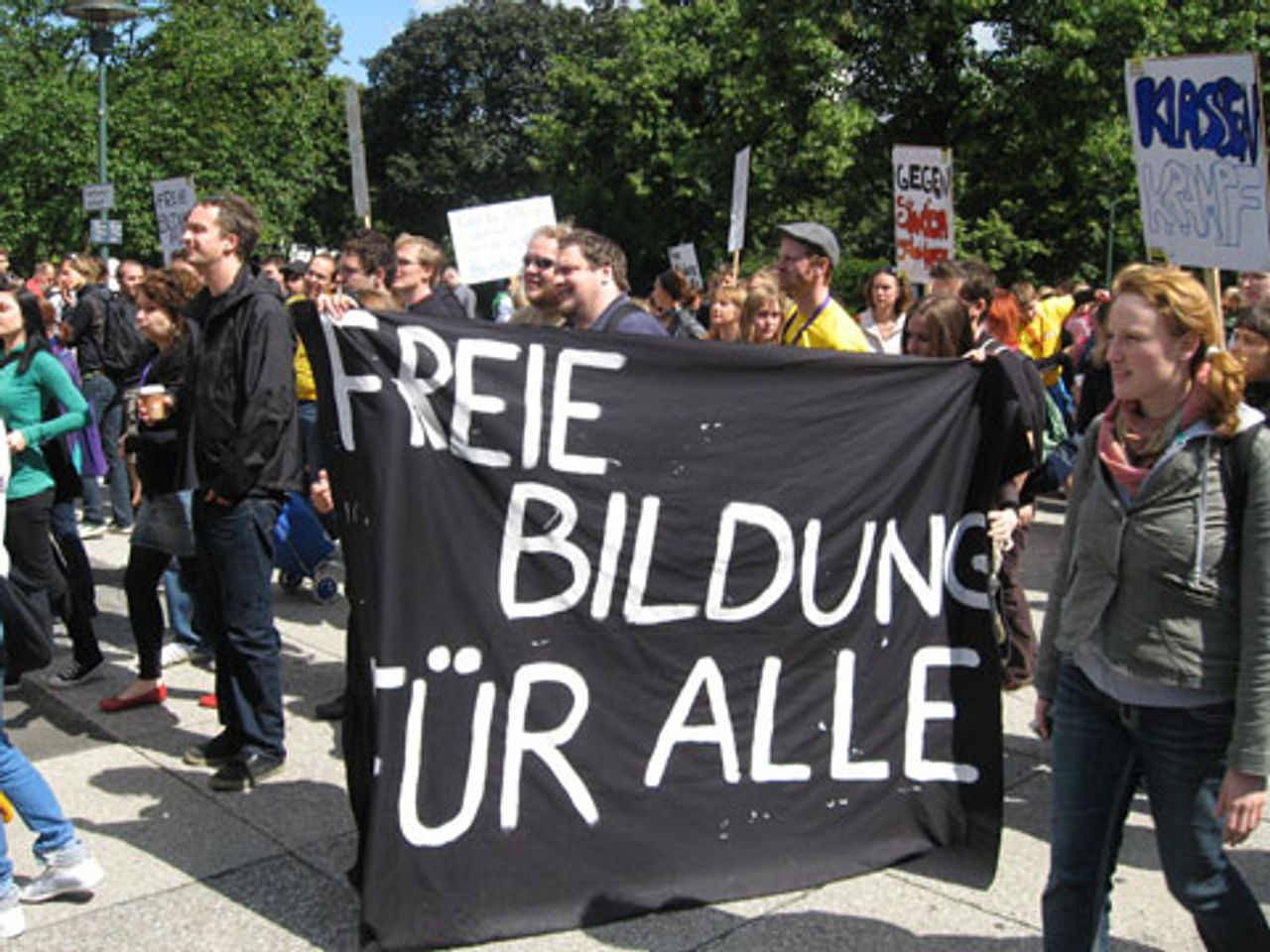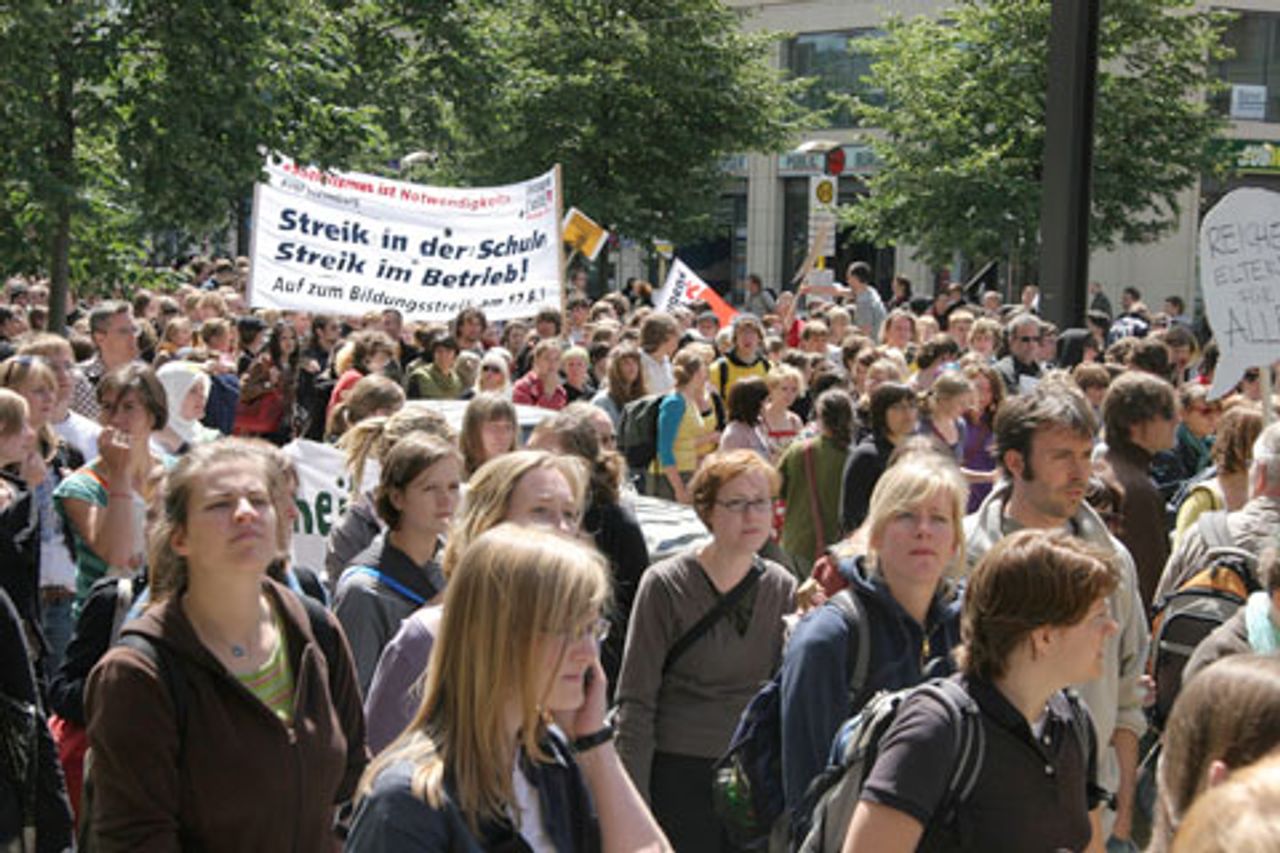 Students holding banner that reads, “Free Education for All”
Students holding banner that reads, “Free Education for All”An estimated 200,000 school and university students and teachers took part in a series of demonstrations in 70 towns and cities across Germany to protest against the run-down of the country's education system. The mass demonstrations on Wednesday were the high point so far in a week of action that has included isolated strikes and protests at individual universities. In the German capital, students temporarily occupied buildings at the Humboldt and Free universities.
Universities have been subjected to a series of drastic cuts in recent years, with many vacant teaching posts remaining unfilled. Budgets for universities have been slashed while money has been freed up for the establishment of elite universities, such as the Einstein Foundation in Berlin. Many of the cuts and deteriorations in university courses have taken place within the framework of the Bologna Process, which was first signed in 1999 and was aimed at transforming education into a commodity.
Adding to the burdens of university students is the decision by the German constitutional court in 2005 to allow state governments to implement new tuition fees. Many German states have either introduced or are in the process of introducing such tuition fees, which can total up to as much as €500 for each semester. The new fees threaten many students with poverty and will inevitably force a considerable number to end their studies prematurely.
Recent media reports give the example of young students forced to work part-time in hotels to supplement their studies. As temporary hotel staff they are expected to clean rooms and make beds for less than €3 per hour.
One of the main demands of university students on Wednesday was “Free Education for all,” with the vast majority of students virulently opposed to the development of a two-tier, income-based education system.
 A section of the student demonstration
A section of the student demonstrationStaff cutbacks and financial cuts across the country have resulted in overfilled seminars and classrooms and a drastic deterioration of the teacher/professor-to-student ratio.
At the same time, new regulations regarding bachelor courses at universities have led to restrictions in the choice of course subjects taken by students, with courses increasingly orientated towards the students’ eventual career. Under conditions where job prospects for graduates are diminishing rapidly due to the current economic and financial crisis, the restrictive career-based course structure combined with decreasing job prospects creates an explosive mix.
While a handful of trade union banners were evident on the Berlin demonstration, the main role of the public service unions with representation amongst teachers and other educational staff has been to defuse and isolate a wave of protest actions and strikes that is taking place across the country. On Monday leaders of the Verdi public service trade union used a protest demonstration by 30,000 childcare workers to create a platform for leading establishment politicians.
Although workers in childcare share many of the problems—in terms of financial cuts and appalling working conditions—that plague students and teachers, the trade unions are conducting a systematic salami tactic to wear down their members. They have refused to organise a joint demonstration of students, teachers and childcare workers.
The run-down of education has been conducted by successive governments—in particular the Social Democratic Party-Green Party coalition (1998-2004) and the current “grand coalition” (SPD-Christian Democratic Union, Christian Social Union). In Berlin, the cuts have been implemented by the city’s senate consisting of a coalition between the SPD and the Left Party.
Many of the participants in the demonstrations across Germany were critical of the role of the establishment parties and the trade unions, and it was notable that none of the speakers at the rally in Berlin represented a trade union or officially acknowledged their allegiance to an established political party.
WSWS reporters attended a number of the demonstrations and interviewed students:
Berlin
Moritz, 22, is studying social sciences at Humboldt University, and Jona, 21, is a student of economic engineering at the Technical University.
Moritz and Jona said that one of the main reasons they were attending the demonstration of an estimated 15,000 in Berlin was to protest the run-down of universities in Berlin and the increasing tendency towards a two-class education system.
Moritz said, “We are demanding that the Senate invest an additional €150 million in Berlin’s universities over the next four years. This money is needed just to maintain the status quo at universities. We are also opposed to the neo-liberalisation of university courses. In particular, the new bachelor courses introduced a few years ago are very restrictive. Choice of subject has been cut back and any interesting or socially critical courses have been trimmed.”
Moritz continued, “The decisions on such financial issues are always political. We are being told now that there is no money for education because of the financial crisis, but money was freed up for the banks, and here in Berlin the elite Einstein Foundation is being funded by the senate to the sum of €40 million. There are also plans to rebuild the city’s City Castle [Stadtschloss] for €100 million. Instead of controversial prestige projects the senate should be investing in basic education and the future of its citizens.”
When questioned on the Berlin senate, Mortiz declared he had no confidence in either the SPD or the Left Party: “The problem with the Left Party is that it is not left. It is social democratic and just trying to repeat the policies the SPD carried out in the 1970s.
“Talk of 1968 is in the air following the 40-year anniversary of those events last year. But it seems to me that one of the main differences between then and now is that many of the 68 students conducted their protests, but were confident they would be able to find jobs at a later stage in their career. Today in the wake of the finance crisis things are very different. We are being trimmed for a specific career but under conditions where it is very questionable we will be able to find a proper paying job at the end of our studies.”
Reporting on the situation at his own university, Jona explained that the level and quality of teaching had declined dramatically—20 professor posts had not been filled at the university since 2003.
Bielefeld
In Bielefeld about 4,500 young people took part in a protest march through the city centre, which ended with a rally in front of the city hall. The demonstration consisted mainly of school students and the lack of attendance from students from the local university and various colleges of further education was striking.
Prior to the demonstration the Administrative Court in Minden had banned the marchers from protesting in the city’s Jahnplatz, which is a central traffic junction. The young demonstrators occupied the Jahnplatz nevertheless and paralyzed suburban traffic for hours. “That was a political decision by the court,” explained student Jannis to our reporter. “At the time of the soccer world championship they made Jahnplatz available to the public, but when it comes to free expression of opinion the square is banned!”
Our reporter spoke with organizers and participants of the demonstration. Hendrik, a member of the organization team and the district student council, drew a positive balance of the action and the substantial participation by pupils: “We were also supported by teaching staffs who are unhappy about the current conditions in their schools.” He was positive about the role played in the dispute by the trade unions and announced new protests for the next school year, to put “pressure on the politicians.” When asked why childcare workers were not taking part in the protests he was forced to concede that the trade union tactics “were inappropriate.”
Leipzig
Around 3,000 students and teachers participated in the demonstration in Leipzig. The demonstration set off from the college of further education (HTWK Leipzig) in the south of the city and grew in size as it progressed. Striking teachers joined the demonstration, and as it made its way through the city centre students from the University of Leipzig also joined the march.
On a host of banners and homemade signs, participants made clear their criticism of the current state of the education system and expressed their anger over the fact that the government had freed up hundreds of billions for the banks, but refused to invest in education and young people.
Robert, who studies cultural science, said that the university was subject to chronic under-financing with a continual reduction in teaching posts, although student numbers were increasing. In his opinion it was necessary to completely rethink the entire Bologna Process, which was jointly responsible for such miserable conditions. When asked if he thought that protest actions such as Wednesday's demonstration could be successful, he was sceptical: “Looking back, the big demo held last year in Dresden was not successful. Since then nothing has changed. Naturally protest is important, but it does not go far enough. There has to be more.”
Equally critical was Mohamed, a student of political science and Arab studies. He was taking part in the demo to achieve better study conditions, improved equipment at the universities and a better education system all round. He was very angry over the way in which the universities turned to the private economy for financing. “In the political science and communication course there is a professor who is funded by the energy group Vattenfall. I ask myself the question, what such a man can teach us or to what extent his teaching is ideologically determined by the company he works for. The worst part about it is that often students do not know the background of the teacher or professor in front of them in the classroom.”
Joining the pupils and students in Leipzig was a teacher, Birgit, who explained, “I am demonstrating because the conditions of work in my occupation have worsened in entirely the same way as the learning conditions for school pupils and students at the universities.” She complained of the noise level where she works because there are too many children in a group. “There are less and less teachers employed, although the demands made upon us are continually growing.” She was uncertain whether the protest would be able to change official policy, but declared it was important, “Never to give up.”
